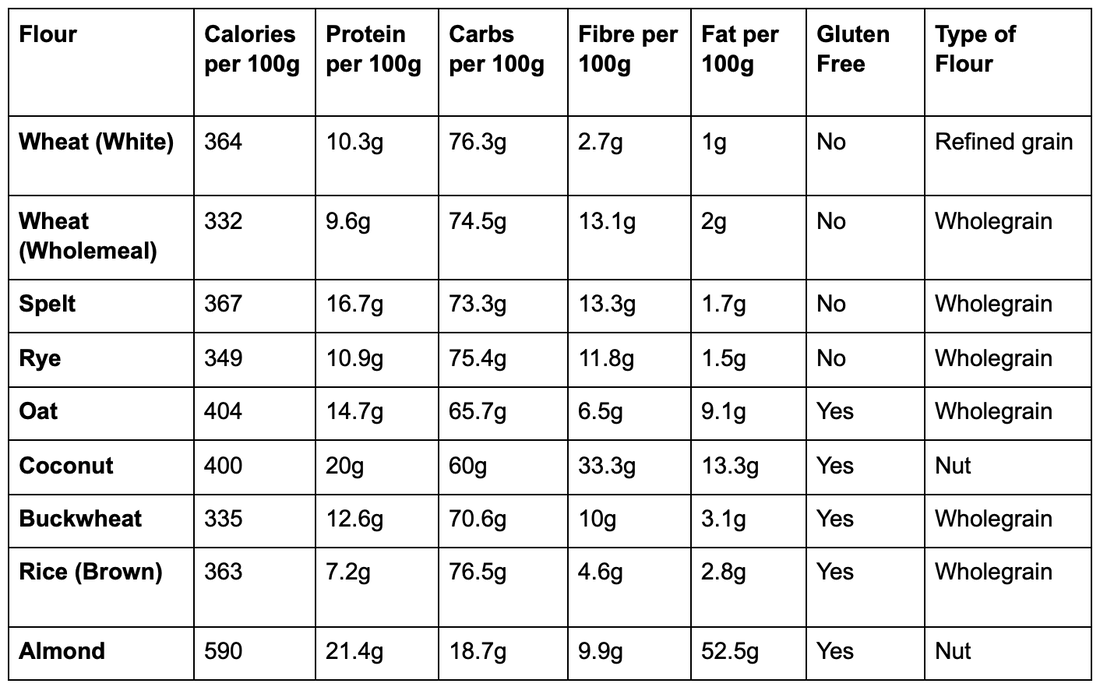|
There are so many types of flours on the market, which differ in consistency, use and nutritional value. From classic wheat flour, through to almond or rye, here’s a quick guide to help you make the right choice.
Wheat Flour Wheat is the most popular and widely used cereal for flour production and is a rich source of fibre. Regular wheat flour, also known as all-purpose or white flour, is refined flour that contains only the endosperm (starch) from the grain. It can also come in wholewheat/wholemeal form which includes the brain, endosperm and germ. This provides wholewheat flour with a slightly darker colour, coarser texture, and higher nutritional value. Wheat is a good source of insoluble fibre and rich in vitamin B1, B3 and B5, riboflavin and folate. It also contains higher amounts of iron, calcium and protein then other types of flour. This flour is commonly used to produce bread, muffins, pasta, pastries, cakes, and biscuits. Spelt Flour Spelt is an ancient grain that consists mostly of starchy sugars so when used creates softer and denser products. When combined with its high fibre content, this helps to slow digestion and increase satiety. Spelt is also high in unsaturated fatty acids, and has high levels of minerals and vitamins, such as magnesium, zinc, manganese, calcium, potassium and B vitamins. It can be used to replace wheat flour in the production of bread, pizza crusts and cookies. Rye Flour Along with wheat and spelt flour, rye is the only other flour that can be used to make bread or yeast. It is a good source of fibre and retains a large amount of nutrients, including iron, magnesium, manganese, potassium, zinc, selenium and B vitamins. Further, it is more effective than wheat flour in reducing LDL cholesterol. Rye flour is most often used for making bread and produces a denser and darker loaf with a coarser texture. Oat Flour Oat flour is naturally gluten free (providing there has been no cross-contamination) and can be made at home by blending whole oats. It has a silky texture and similar taste to wheat flour, except with a higher protein content. It is also high in magnesium, iron, zinc, selenium and soluble fibre, particularly beta-glucan, which helps induce feelings of satiety. Further, oats are high in antioxidants, such as avenanthramides, which help to lower blood pressure. Oat flour can be used as a gram-for-gram replacement for wheat flour in pancakes, cakes, biscuits, etc. Coconut Flour Coconut flour is made by grinding and drying coconut pulp. It is another gluten free flour alternative with a higher protein, fibre and fat content, and lower carbohydrate content. Coconut flour contains medium chain triglycerides which help produce energy and reduce appetite. It has a slightly sweeter and coconutty flavour compared to wheat flour and can be used as a replacement in desserts and pastries. Due to its fibrous nature and lower density, it is important to not use too much or to add more binding agents to your batter. Buckwheat Flour Buckwheat is a type of gluten free pseudocereal, which means its seeds do not grow on grass. It is often considered a superfood due to its high content of protein, calcium, potassium, magnesium, folate, B6 and vitamin K. It also has a lower glycaemic index, which makes it ideal for people with type 2 diabetes. Buckwheat has a nutty flavour and is often used as a substitute for wheat flour in noodles, porridge, and baking. Since it absorbs a lot of moisture, more liquid should be added to batters before baking. Rice Flour Rice flour is made by grinding white or brown rice. It is more nutritious than wheat flour and a good source of fibre, vitamins, and minerals, such as calcium and zinc. It also contains choline, which helps maintain a healthy liver. Rice flour is more affordable than other gluten free flour varieties. It is most often used as an alternative thickener in chilled or frozen food recipes because it inhibits the separation of liquids. Rice flour’s neutral flavour and high starch content, which creates elasticity in doughs, also makes it ideal for sponge cakes, noodles, and fritters. Almond Flour/Meal Almond meal is made from ground almonds that are blanched, crushed and sieved. It can also be made at home by pulverising almonds into a fine flour. Almond meal is very high in healthy fats, proteins, manganese, magnesium, calcium and vitamin E. It is also rich in magnesium, which assists with controlling blood sugar levels and reducing insulin resistance. It can be rather oily or moist but is easily used as a gluten free substitute for wheat flour when making pizza bases, desserts, and raw treats. Ultimately, there is no correct answer for which type of flour is best. It depends on what you are trying to make and the properties you desire, such as gluten-free, high protein, low carb, or high fibre. Use this table to find which one is best for you.
0 Comments
Leave a Reply. |
Monica AnderssonMonica leads NordicHealth, a naturopathic and remedial massage clinic in Mosman on Sydney’s North Shore. Archives
August 2023
Categories
All
|
Contact Nordichealth to Reach Your Health Goals Naturally
Based in Mosman - Home Visits Available
Phone: 0416 262 114 | Email: monica@nordichealth.com.au
Practice Hours: In clinic - Tuesdays and Thursdays 9 am - 8 pm and Fridays 12 - 5 pm | Home Visits: Mondays
Phone: 0416 262 114 | Email: monica@nordichealth.com.au
Practice Hours: In clinic - Tuesdays and Thursdays 9 am - 8 pm and Fridays 12 - 5 pm | Home Visits: Mondays
HOME | MEET MONICA | NATUROPATHY | MASSAGE SERVICES | TREATMENT FEES | CONTACT | USEFUL LINKS | BLOG
Web Design by SBWD


 RSS Feed
RSS Feed

